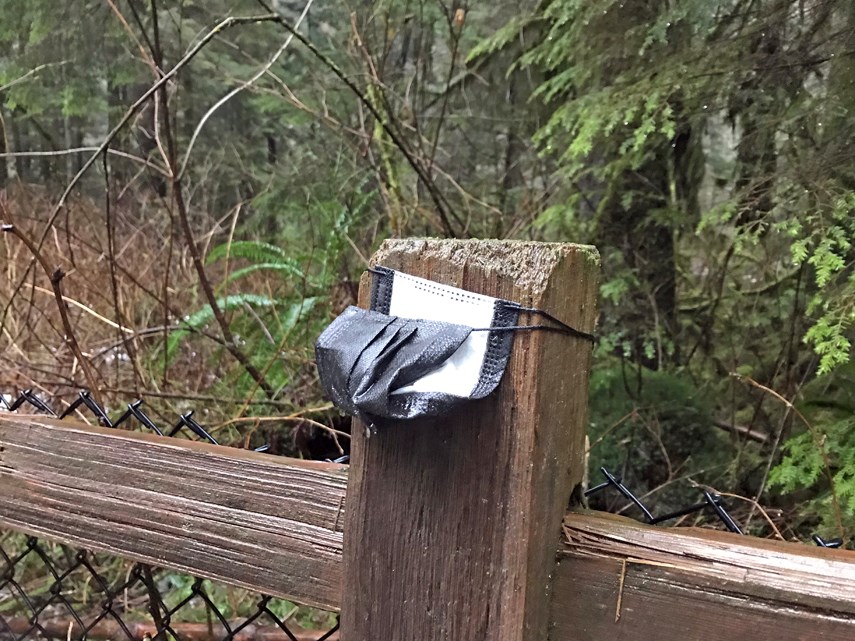Archeologist and Capilano University instructor Bob Muckle wants to record and document that history, and ultimately, surmise what the prevalence of these items has meant for us.
Since January, Muckle and two research assistants have been documenting the COVID-19-related art, structures and artifacts (read: discarded masks) that quickly became prevalent over the last year.
The trio has been recording the material world during the pandemic mainly through photography and posting some of their efforts using the Twitter account @Covidarcheology.
A picture of a discarded face mask found hanging on a fence in North Vancouver, a sign that reads “Have a heart – stay two metres apart” in the Fraser Valley, and colourfully-painted pebbles or rocks urging people across the region to “Stay safe” or “Keep calm” are the kinds of now commonplace items the group has been recording.
The painting, placing, and finding of painted pebbles is not necessarily a COVID-related activity, but COVID clearly created a revitalization of this kind of thing. These are some of the many recently seen North Vancouver pic.twitter.com/IoeFkoq8c7
— Covidarchaeology (@Covidarcheology) February 24, 2021
“I’m trying to get a handle on how many masks might be out there,” noted Muckle. “I have this interest in the environmental impact of all the COVID waste. Some of it’s so visible.”
Inspired by a similar archeological initiative in the U.K. which invited people across the world to record the signs, marks and graffiti of COVID-19, Muckle describes his current project as documenting the human responses in contemporary times to the pandemic.
In the initial phase of the project, his research assistants have largely been collecting examples of the murals, graffiti, painted pebbles, signs, barriers, and discarded personal protective equipment on the North Shore and in Vancouver.
“What I feel passionate about is it gives us the chance to actually observe the making of the archeological record. We’re seeing this trash, we’re seeing these structures, we’re seeing this art being created – and it will go away. But it will be recorded in the archeological record,” said Muckle. “What I’m after is what the various responses were and why those responses?”
Muckle’s project is funded by Capilano University, who put a callout last year for research projects related to the pandemic.
Masked lions. West Vancouver 2021 pic.twitter.com/6aEafUhj8G
— Covidarchaeology (@Covidarcheology) March 9, 2021
While the direction Muckle’s data collection will take should be narrowed down even further after his assistants wrap up their documentation next month, he anticipates taking a closer look at how the material culture during the pandemic – the art, the graffiti, the different warning signs – was different in a place like the Downtown Eastside compared to the North Shore.
“We’re seeing far fewer discarded cloth masks or reusable masks in the Downtown Eastside than we are in North Vancouver,” said Muckle, adding that discarded non-reusable masks were a more common occurrence downtown, possibly due to income disparities.
Following the recent release of a Metro Vancouver report weighing the impact the pandemic has had on trash in the region, Muckle also said he hoped his contributions to the COVID-era archeological record could help shed even more light on the environmental impact of the last year.
“They’re actually starting to document how many masks and gloves and wipes are in the trash now,” said Muckle. “Why is it that some people are expressing themselves through art and why are some people deliberately throwing away masks?”
According to the report by Metro’s zero waste committee, Metro Vancouver residents threw out more than 100-million masks in 2020.
Emily Bridge, a Capilano University student and research assistant on the COVID archeology project, says she has traversed the North Shore several times over the past many months in order to document the unique material items of this time.
“I spend a lot of time looking at the ground looking for masks and garbage, as well as signage. I’ve been looking at the difference in signs across the municipality,” said Bridge.
Covid signage. North Vancouver, Canada pic.twitter.com/jqQxiYpwRR
— Covidarchaeology (@Covidarcheology) February 24, 2021
Anecdotally, she’s observed more COVID-related art, like positive messages or painted rocks, in more affluent communities such as Dundarave, Edgemont or Pemberton Heights, she said.
She wanted to be part of this project in order to help put together the archeological record before the remnants of this period disappeared from sight.
One sight she really started to notice once she was looking for discarded PPE masks and gloves in North Shore neighbourhoods, commercial areas and parks was the sheer amount of discarded items there was in general.
“I have lived here almost my whole life on the North Shore and I’m never noticed really how much garbage there is. There is a lot of trash. I’m surprised honestly.”



